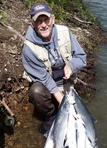Darrell Keifer's Blog: My Brand
May 15, 2019
My Brand
I like near-future science fiction grounded in hard science and realism. So, I avoid magic or supernatural elements in my stories, unless the supernatural features are metaphorical like the fairies in Shakespeare’s "A Midsummer Night’s Dream." (Here, Shakespeare uses fairies to represent basic human drives and desires that we are often blind to.)
I consider my novel, “A Hope in Hell” environmental fiction. It wasn’t even a term with I began writing "A Hopein Hell", but I am delighted the genre has developed. Too often apocalypse stories are classified as dystopian, or near fantasy, but there are two important elements that set environmental fiction apart—realism and narrative anthropology.
Realism: When we (readers) are invited to a story, we come with a willing suspension-of-disbelief, and I have as strong a suspension-of-disbelief as anyone—what if dinosaurs could be grown from ancient DNA?, or what if an asteroid struck the earth?, but the ground rules of what-ifs should be laid out and not include a sweeping suspension of the laws of physics, nature, and common sense. So, no hundred-and-ten pound woman, with toothpick arms, and dressed in cleavage revealing spandex, beating up twelve burly guys.
Narrative anthropology: Anthropology is the study of humans, human behavior, and societies in the past and present. Revealing those science-based observations, theories, and principles through narrative is fun, moving, and meaningful.
One of the best known anthropological studies used in many modern novels and movies is Joseph Campbell’s "The Hero with a Thousand Faces." It lays out the step by step elements of a hero’s journey common in most myths and stories. George Lucus’s "Star Wars" is a good example because it closely followed Campbell’s work.
There are many anthropologic studies that provide overarching theories of human behavior and culture. One body of work, I like and am familiar with, is Rene Girard’s mimetic theory and his work on scapegoating ("I see Satan Fall like Lightning"). "The Hunger Games" is classic Girardian. (I’ll post more on mimetic theory later)
So, following these precepts I hope to write stories that snatch meaning from the dragon’s jaws, tickle imaginations, quicken hearts, and nourish souls. Good reading!
I consider my novel, “A Hope in Hell” environmental fiction. It wasn’t even a term with I began writing "A Hopein Hell", but I am delighted the genre has developed. Too often apocalypse stories are classified as dystopian, or near fantasy, but there are two important elements that set environmental fiction apart—realism and narrative anthropology.
Realism: When we (readers) are invited to a story, we come with a willing suspension-of-disbelief, and I have as strong a suspension-of-disbelief as anyone—what if dinosaurs could be grown from ancient DNA?, or what if an asteroid struck the earth?, but the ground rules of what-ifs should be laid out and not include a sweeping suspension of the laws of physics, nature, and common sense. So, no hundred-and-ten pound woman, with toothpick arms, and dressed in cleavage revealing spandex, beating up twelve burly guys.
Narrative anthropology: Anthropology is the study of humans, human behavior, and societies in the past and present. Revealing those science-based observations, theories, and principles through narrative is fun, moving, and meaningful.
One of the best known anthropological studies used in many modern novels and movies is Joseph Campbell’s "The Hero with a Thousand Faces." It lays out the step by step elements of a hero’s journey common in most myths and stories. George Lucus’s "Star Wars" is a good example because it closely followed Campbell’s work.
There are many anthropologic studies that provide overarching theories of human behavior and culture. One body of work, I like and am familiar with, is Rene Girard’s mimetic theory and his work on scapegoating ("I see Satan Fall like Lightning"). "The Hunger Games" is classic Girardian. (I’ll post more on mimetic theory later)
So, following these precepts I hope to write stories that snatch meaning from the dragon’s jaws, tickle imaginations, quicken hearts, and nourish souls. Good reading!
Published on May 15, 2019 14:32



